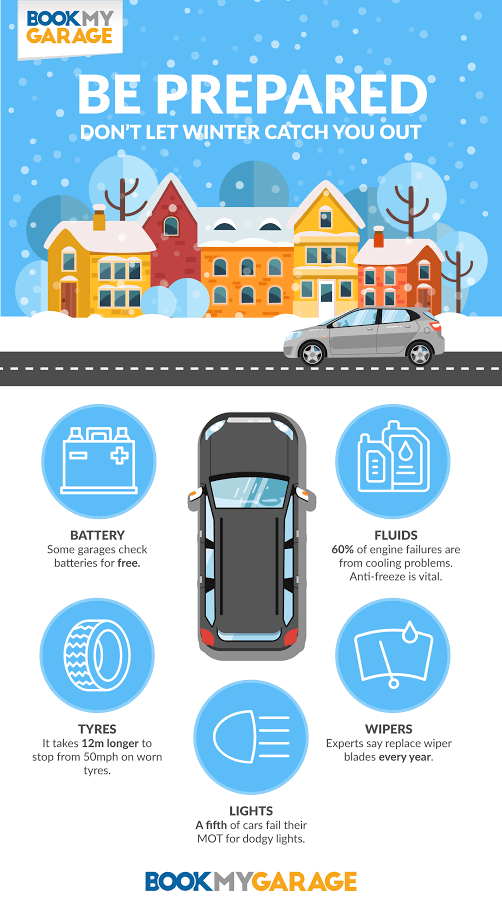Before hitting the road in winter, a few simple checks can help you keep your car safe and reliable – no matter the weather.
Changes in temperature can spell trouble for your vehicle, so it pays to think ahead.
Ensure your car is winter-ready by carrying out the following maintenance and winter car care checks.

Page Contents
Check and Top Up Fluids
A vehicle breakdown is never enjoyable – least of all in the colder months!
If you’re planning on visiting loved ones this winter, make sure you have enough fuel for the trip.
Low oil levels can cause severe engine damage, so you should check and top up your oil levels before setting off, too.
As temperatures drop, your engine can freeze or even overheat despite the cold if you have too little or too much coolant.
Though the coolant system is sealed and should not require regular top ups, you should check your coolant levels in winter – and do so when the engine is cold.
Small leaks can develop over time, with the coolant system having to work harder in winter – using sufficient coolant can help your vehicle maintain a stable engine temperature.
Check Your Battery
In winter, your battery will require more of a current to start up a cold engine – and more electronics are likely to be in use this time of year.
Turning on your radio, heaters and alarm system as soon as you start your car can put additional strain on the battery, so you should let your engine turn over before doing so.
Don’t forget to turn these electronics off when you leave the car!
Driving your car regularly for over 30 minutes at a time can help to charge your car battery and keep it warm.
When you aren’t using the vehicle, storing it in a garage can keep your vehicle out of the cold.
If you aren’t planning on using your vehicle much at this time of year, you should still start the engine regularly to take care of your battery.
You should also check the battery terminals for any corrosion and inspect them to see that they are fitted properly and aren’t in need of cleaning.
When your battery is over three years old, you should have it checked regularly by a professional mechanic to ensure your battery always holds a charge.
For electric vehicles, you should make sure that your battery is charged before setting off and plan your route ahead of time so that you know where you can next charge it.
Check Tyre Tread and Pressure
You need sufficient tyre tread all year round, but this is especially important when driving on icy or snowy roads.
Your tyres should have at least 3mm of tread to ensure traction with the road’s surface.
Tyre pressure is also important, as low tyre pressure can lead to uneven tyre wear, as well as an increased risk of overheating and punctures.
You can check your tyre pressure at a petrol station using a pressure gauge to the appropriate tyre pressure stated by your vehicle’s manufacturer.
Carry out a visual inspection to look for lumps, cuts or bulges whilst you’re at it – you should have your tyres replaced right away if you notice any issues.
Consider Switching to Winter Tyres
You may wish to change to winter tyres, which are designed to stay flexible in colder temperatures and can disperse snow and water.
Alternatively, you could invest in snow socks or chains – though these can’t be used on roads that aren’t covered in snow.
Check Your Brakes
Your brake discs, calipers and the handbrake can freeze if you don’t use your vehicle for a while in the colder months.
Your brakes can also become rusty in winter due to wet and salt-covered road conditions.
If you’ve noticed significant rust or changes in the behaviour of your car brakes – such as squeaking or the pedal feels soft - you should have them inspected by a professional mechanic.
Check and Replace Your Wiper Blades
Wiper blades have a vital role to play in keeping your windscreen clear or rain and snow.
To ensure you stay safe whilst driving, you should check your wiper blades for any signs of wear.
If you notice streaks on your windscreen, then your wiper blades may have worn out and need to be replaced.
Cracked, damaged or bent rubber can also indicate that the blades aren’t working properly.
Inspect Your Lights
As it gets darker earlier in winter, your lights must work properly to guide you on the road.
Check each light is working by turning them on individually – having someone on hand to help you check that the relevant light is turning on can make the process easier.
Make sure your lights are free of grime or dirt at all times and be sure to keep spare bulbs in your car in case you need them.
Don't Ignore Dashboard Warning Lights
Dashboard warning lights are there to give you the chance to fix issues early on – so you shouldn’t ignore them for long.
These lights can be green, yellow or red depending on the severity of the problem.
Some important warning lights that may show on your car’s dashboard include the EML and DPF warning lights.
Put Together an Emergency Kit
In addition to routine maintenance, keeping an emergency kit in your car can give you peace of mind as you drive in changing weather conditions.
Including handy items like a first aid kit, de-icer, jump leads and tyre inflator, a car kit can help you handle a range of issues.
You can buy a ready-made kit or assemble one yourself – and you’ll be glad you have one if you ever experience a vehicle breakdown.
Not to mention that keeping books and games in the car can keep you and your family entertained whilst you wait for assistance.
Now that you’ve checked your vehicle is ready for winter and equipped with a handy car kit, you’re ready to enjoy the colder months.
For added peace of mind, why not book a Winter Health Check through BookMyGarage this year?
That way you can drive knowing your battery and other essential components are working optimally to get you through the season.








No comments yet
Leave a comment